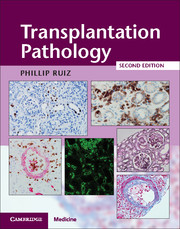Book contents
- Transplantation Pathology
- Transplantation Pathology
- Copyright page
- Dedication
- Contents
- Contributors
- Preface
- Chapter 1 Immunopathology of Organ Transplantation
- Chapter 2 The Pathology of Kidney Transplantation
- Chapter 3 Histopathology of Liver Transplantation
- Chapter 4 The Pathology of Heart Transplantation
- Chapter 5 The Pathology of Lung Transplantation
- Chapter 6 The Pathology of Intestinal and Multivisceral Transplantation
- Chapter 7 Pancreas and Islet Transplantation Pathology
- Chapter 8 Pathology of Hematopoietic Stem Cell Transplantation
- Chapter 9 Dermatological Complications in Transplant Patients and Composite Tissue Allotransplant Pathology
- Chapter 10 Malignancies of Transplantation
- Chapter 11 Laboratory Medicine in Transplantation
- Index
- References
Chapter 10 - Malignancies of Transplantation
Published online by Cambridge University Press: 17 March 2018
- Transplantation Pathology
- Transplantation Pathology
- Copyright page
- Dedication
- Contents
- Contributors
- Preface
- Chapter 1 Immunopathology of Organ Transplantation
- Chapter 2 The Pathology of Kidney Transplantation
- Chapter 3 Histopathology of Liver Transplantation
- Chapter 4 The Pathology of Heart Transplantation
- Chapter 5 The Pathology of Lung Transplantation
- Chapter 6 The Pathology of Intestinal and Multivisceral Transplantation
- Chapter 7 Pancreas and Islet Transplantation Pathology
- Chapter 8 Pathology of Hematopoietic Stem Cell Transplantation
- Chapter 9 Dermatological Complications in Transplant Patients and Composite Tissue Allotransplant Pathology
- Chapter 10 Malignancies of Transplantation
- Chapter 11 Laboratory Medicine in Transplantation
- Index
- References
- Type
- Chapter
- Information
- Transplantation Pathology , pp. 312 - 341Publisher: Cambridge University PressPrint publication year: 2018



